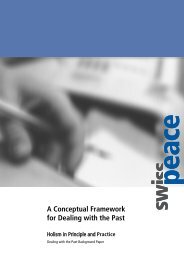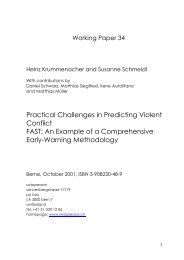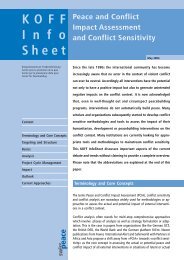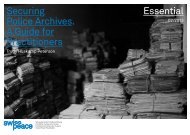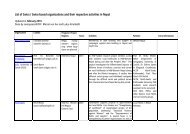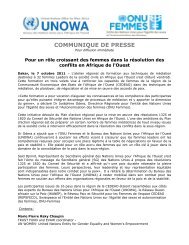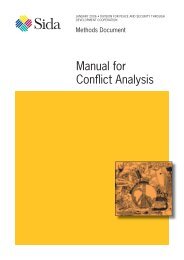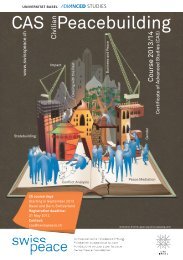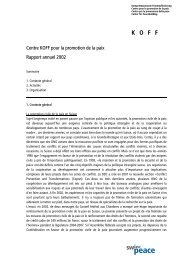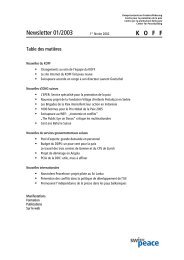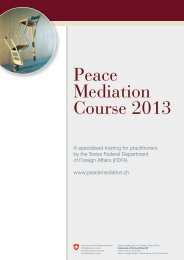Unpacking the Mystery of Mediation in African Peace ... - Swisspeace
Unpacking the Mystery of Mediation in African Peace ... - Swisspeace
Unpacking the Mystery of Mediation in African Peace ... - Swisspeace
You also want an ePaper? Increase the reach of your titles
YUMPU automatically turns print PDFs into web optimized ePapers that Google loves.
<strong>Unpack<strong>in</strong>g</strong> <strong>the</strong> <strong>Mystery</strong> <strong>of</strong> <strong>Mediation</strong> <strong>in</strong> <strong>African</strong> <strong>Peace</strong> Processes<br />
rebel groups were not signatories <strong>of</strong> <strong>the</strong> Arusha<br />
Accord, signed <strong>in</strong> 2000.<br />
<strong>Mediation</strong> Style and Third-Party<br />
Coord<strong>in</strong>ation<br />
The regional <strong>African</strong> states’ most significant <strong>in</strong>itiative<br />
– economic sanctions aga<strong>in</strong>st <strong>the</strong> Burundi<br />
government and mediation under <strong>the</strong> auspices <strong>of</strong><br />
Nyerere – suffered, at least <strong>in</strong>itially, from lack <strong>of</strong><br />
sufficient Western support. The regional states<br />
clearly pushed <strong>the</strong> Burundian conflict parties <strong>in</strong><br />
<strong>the</strong> direction <strong>of</strong> political negotiation. European<br />
and US reservations were based on <strong>the</strong>ir belief<br />
that it was necessary to work through moderate<br />
political leaders and that a relaxation <strong>of</strong> sanctions<br />
would streng<strong>the</strong>n moderate forces for peace. But<br />
<strong>the</strong> Burundi government’s military-oriented policies<br />
<strong>in</strong>dicated that relative extremists were largely<br />
<strong>in</strong> control. This suggested <strong>the</strong> need for more<br />
ra<strong>the</strong>r than less outside pressure, carefully orchestrated<br />
to br<strong>in</strong>g <strong>the</strong> radical rebel groups <strong>in</strong>to<br />
power-shar<strong>in</strong>g negotiations that could protect<br />
<strong>the</strong>ir essential <strong>in</strong>terests. 21<br />
A plethora <strong>of</strong> non-state mediation organizations<br />
were active <strong>in</strong> Burundi, <strong>in</strong>clud<strong>in</strong>g <strong>the</strong> Carter Center<br />
22 , <strong>the</strong> Community <strong>of</strong> Sant’Egidio 23 , The Center<br />
for Humanitarian Dialogue (HD) 24 , and Synergies<br />
Africa 25 . Some <strong>of</strong> <strong>the</strong>se efforts helped to<br />
keep <strong>the</strong> peace process mov<strong>in</strong>g while <strong>the</strong> <strong>of</strong>ficial<br />
Arusha talks were stalled, e.g. efforts <strong>of</strong><br />
Sant’Egidio <strong>in</strong> 1997 or by <strong>the</strong> Swiss Federalism<br />
Institute and Synergies Africa <strong>in</strong> March 1998.<br />
21 Weissman (1998): op. cit.<br />
22 The Carter Center sponsored talks <strong>in</strong> 1995 and 1996, cochaired<br />
by Julius Nyerere and Jimmy Carter. Hara (1999): op.cit., p.<br />
146.<br />
23 Sant’Egidio had contacts with <strong>the</strong> parties s<strong>in</strong>ce 1995, and held<br />
secret talks <strong>in</strong> Rome lead<strong>in</strong>g to an outl<strong>in</strong>e agreement <strong>in</strong> 1997<br />
(Ibid., p. 147). Don Mateo Zuppi, a member <strong>of</strong> St. Egidio, had<br />
<strong>the</strong> <strong>of</strong>fice <strong>of</strong> <strong>the</strong> president <strong>of</strong> <strong>the</strong> commission for <strong>the</strong> "ceasefire<br />
and disarmament" <strong>in</strong> <strong>the</strong> <strong>of</strong>ficial Arusha talks under Nyerere<br />
and Mandela. Sant Egidio website: (http://www.santegidio.org/en/pace/pace6.htm)<br />
24 HD was <strong>in</strong>volved <strong>in</strong> 1999 <strong>in</strong> efforts to establish communication<br />
channels with <strong>the</strong> armed groups. In Feb 2000 HD hosted a<br />
sem<strong>in</strong>ar <strong>in</strong> Geneva to start a dialogue on humanitarian issues. It<br />
ended <strong>the</strong>se efforts <strong>in</strong> August 2000, however, so as not to distract<br />
from <strong>the</strong> <strong>the</strong>n-ongo<strong>in</strong>g political negotiations <strong>in</strong><br />
Arusha. HD website: (http://www.hdcentre.org/projects/burundi/activities?hd-centre-ends-its-<strong>in</strong>volvement-burundi)<br />
25 Synergies Africa helped set up a conference <strong>in</strong> 1997 and sem<strong>in</strong>ar<br />
<strong>in</strong> 1998. Hara (1999): op. cit., p. 147-150.<br />
24<br />
However, parallel efforts by non state mediators<br />
also posed <strong>the</strong> danger <strong>of</strong> giv<strong>in</strong>g certa<strong>in</strong> spl<strong>in</strong>ter<br />
groups some form <strong>of</strong> legitimacy while not be<strong>in</strong>g<br />
at <strong>the</strong> table, or giv<strong>in</strong>g <strong>the</strong> parties an excuse to exit<br />
<strong>the</strong> Arusha process. 26 This was also why HD<br />
stopped its efforts to establish a dialogue on humanitarian<br />
issues <strong>in</strong> August 2000. 27 Thus <strong>the</strong> Burundi<br />
case shows <strong>the</strong> potential <strong>of</strong> various third<br />
parties, but also that too many actors can threaten<br />
a process if <strong>the</strong>y are not well coord<strong>in</strong>ated.<br />
Arusha Process<br />
The Arusha process was structured <strong>in</strong>to five<br />
committees deal<strong>in</strong>g with <strong>the</strong> follow<strong>in</strong>g topics: 1)<br />
nature <strong>of</strong> <strong>the</strong> conflict, 2) democracy, good governance,<br />
and constitutional arrangements28 , 3)<br />
peace and security, 4) reconstruction and development,<br />
5) guarantees to support implementation<br />
<strong>of</strong> <strong>the</strong> accord. Besides <strong>the</strong> chief mediators<br />
Nyerere and later Mandela, <strong>the</strong>re were some two<br />
dozen people <strong>in</strong> <strong>the</strong> facilitation team between <strong>the</strong><br />
Tanzanian Facilitation and <strong>the</strong> International<br />
ones.<br />
The mediators <strong>of</strong> <strong>the</strong> second committee structured<br />
<strong>the</strong> agenda by gett<strong>in</strong>g <strong>the</strong> parties to talk<br />
about <strong>the</strong> 1992 constitution, which had been very<br />
widely accepted <strong>in</strong> a referendum. The parties<br />
were set <strong>the</strong> task <strong>of</strong> mak<strong>in</strong>g three columns: 1) acceptable<br />
po<strong>in</strong>ts that <strong>the</strong>y agreed with, 2) problematic<br />
po<strong>in</strong>ts that could, however, be dealt with<br />
once <strong>the</strong> ma<strong>in</strong> hurdles had been overcome, 3) unacceptable<br />
po<strong>in</strong>ts, which were absolutely “no-go”<br />
areas. The agenda was set follow<strong>in</strong>g <strong>the</strong> second<br />
and third po<strong>in</strong>ts. In this process, <strong>the</strong> mediators<br />
were look<strong>in</strong>g for <strong>in</strong>stitutional sett<strong>in</strong>gs and constitutional<br />
pr<strong>in</strong>ciples that would help br<strong>in</strong>g Burundi<br />
out <strong>of</strong> its actual crisis and start solv<strong>in</strong>g <strong>the</strong> political<br />
crisis through power shar<strong>in</strong>g mechanisms.<br />
A work<strong>in</strong>g draft document presented by <strong>the</strong> mediators,<br />
based on <strong>the</strong> 1992 constitution and <strong>the</strong><br />
talks that had taken place so far, was rejected by<br />
all <strong>the</strong> parties. This is <strong>in</strong> fact better than if it is accepted<br />
by some parities, but rejected by o<strong>the</strong>rs, as<br />
<strong>the</strong> mediator is <strong>the</strong>n viewed as be<strong>in</strong>g biased. The<br />
26 Hara (1999): op.cit., p. 150.<br />
27 (http://www.hdcentre.org/projects/burundi/activities?hd-centreends-its-<strong>in</strong>volvement-burundi)<br />
28 Chaired by Nicolas Haysom and Julian T Hott<strong>in</strong>ger.




